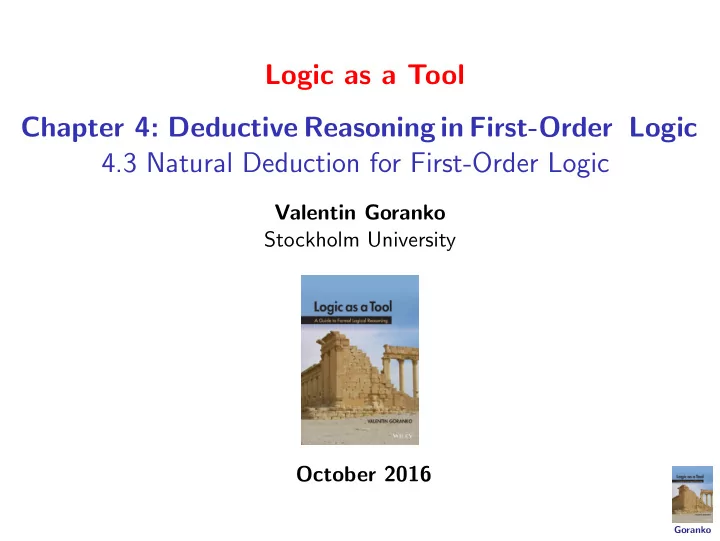

Logic as a Tool Chapter 4: Deductive Reasoning in First-Order Logic 4.3 Natural Deduction for First-Order Logic Valentin Goranko Stockholm University October 2016 Goranko
Natural Deduction ◮ ND : System for structured deduction from a set of assumptions, based on rules, specific to the logical connectives. ◮ For each logical connective: introduction rule(s) and elimination rule(s) ◮ Introduction (opening) and cancelation (closing, discharge) of assumptions . Assumptions can be re-used many times before canceled. ◮ Cancelation of assumptions: only when the rules allow it, but not an obligation. ◮ All open assumptions at the end of the derivation must be declared. The less assumptions, the stronger the derivation. Goranko
Quantifier rules for Natural Deduction Introduction rules: Elimination rules: A [ c / x ] ∀ xA ( x ) ( ∀ I ) ∗ ( ∀ E ) ∗∗ ∀ xA ( x ) A [ t / x ] [ A [ c / x ]] 1 . A [ t / x ] . . ( ∃ I ) ∗∗ ∃ xA ( x ) ∃ xA ( x ) C ( ∃ E ) ∗∗∗ 1 C ∗ where c is a constant symbol, not occurring in A ( x ) , nor in any open assumption used in the derivation of A [ c / x ] . ∗∗ for any term t free for x in A . ∗∗∗ where c is a constant symbol, not occurring in A ( x ) , nor in C or in any open assumption in the derivation of C , except for A [ c / x ] . Goranko
First-order Natural Deduction: Warning: a common mistake How about replacing the rule ( ∃ E ) with the following, simpler one? ∃ xA ( x ) ( ∃ E ′ ) A [ c / x ] where c is a new constant symbol. Though simple and looking natural, this rule is not valid! Using it, one can derive the invalid implication ∃ xA ( x ) → A [ c / x ]. Goranko
Notational convention When A = A ( x ), i.e., x occurs free in A , and t is free for substitution for x in A , we sometimes write A ( t ) instead of A [ t / x ]. Goranko
First-order Natural Deduction: Example 1 ⊢ ND ∀ x ∀ yP ( x , y ) → ∀ y ∀ xP ( x , y ) : [ ∀ x ∀ yP ( x , y )] 1 ( ∀ E ) ∀ yP ( c 1 , y ) ( ∀ E ) P ( c 1 , c 2 ) ( ∀ I ) ∀ xP ( x , c 2 ) ( ∀ I ) ∀ y ∀ xP ( x , y ) ( → I ) 1 ∀ x ∀ yP ( x , y ) → ∀ y ∀ xP ( x , y ) Goranko
First-order Natural Deduction: Example 2 ∀ x ( P ( x ) ∧ Q ( x )) ⊢ ND ∀ xP ( x ) ∧ ∀ xQ ( x ) : ( ∀ E ) ∀ x ( P ( x ) ∧ Q ( x )) ( ∀ E ) ∀ x ( P ( x ) ∧ Q ( x )) P ( c ) ∧ Q ( c ) P ( c ) ∧ Q ( c ) ( ∧ E ) ( ∧ E ) P ( c ) Q ( c ) ( ∀ I ) ( ∀ I ) ∀ xP ( x ) ∀ xQ ( x ) ( ∧ I ) ∀ xP ( x ) ∧ ∀ xQ ( x ) Goranko
First-order Natural Deduction: Example 3 ¬∃ x ¬ A ( x ) ⊢ ND ∀ xA ( x ) : [ ¬ A ( c )] 1 ¬∃ x ¬ A ( x ) ∃ x ¬ A ( x ) ⊥ 1 A ( c ) ∀ xA ( x ) Goranko
First-order Natural Deduction: Example 4 ¬∀ x ¬ A ( x ) ⊢ ND ∃ xA ( x ) : [ A ( c )] 1 [ ¬∃ xA ( x )] 2 ∃ xA ( x ) ⊥ 1 ¬ A ( c ) ¬∀ x ¬ A ( x ) ∀ x ¬ A ( x ) ⊥ 2 ∃ xA ( x ) Goranko
First-order Natural Deduction: Example 5 Suppose x is not free in P . Then ⊢ ND ∀ x ( P → Q ( x )) → ( P → ∀ xQ ( x )): ( ∀ E ) [ ∀ x ( P → Q ( x ))] 1 [ P ] 2 , P → Q ( c ) ( → E ) Q ( c ) ( ∀ I ) ∀ xQ ( x ) ( → I ) 2 P → ∀ xQ ( x ) ( → I ) 1 ∀ x ( P → Q ( x )) → ( P → ∀ xQ ( x )) Goranko
First-order Natural Deduction: Example 6 Suppose x is not free in P . Then ∀ x ( Q ( x ) → P ) , ∃ xQ ( x ) ⊢ ND P : ( ∀ E ) ∀ x ( Q ( x ) → P ) [ Q ( c )] 1 , Q ( c ) → P ( → E ) ∃ xQ ( x ) P ( ∃ E ) 1 P Goranko
First-order Natural Deduction: a challenge! Derive in ND the formula: ∃ x ( P ( x ) → ∀ yP ( y )) Goranko
Recommend
More recommend